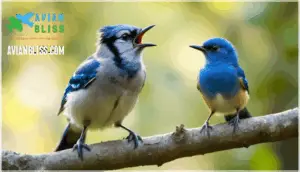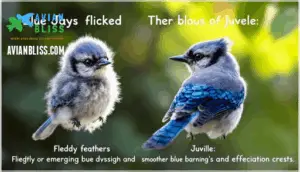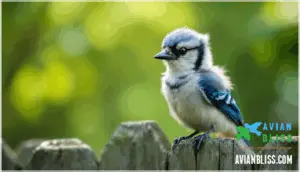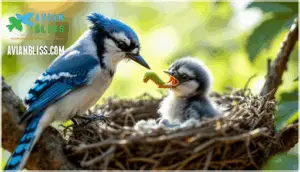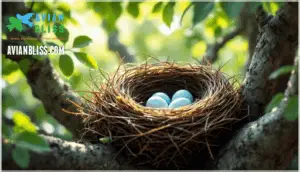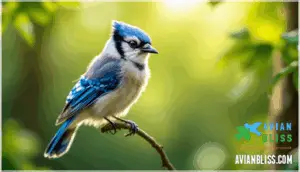This site is supported by our readers. We may earn a commission, at no cost to you, if you purchase through links.
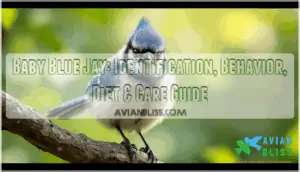 You spot a fluffy gray bird begging loudly from a branch, and your first thought is "baby robin." Look closer—those faint blue wing tips tell a different story.
You spot a fluffy gray bird begging loudly from a branch, and your first thought is "baby robin." Look closer—those faint blue wing tips tell a different story.
Baby blue jays don’t arrive wearing their parents’ striking cobalt uniform. Instead, they spend weeks in muted disguise, passing through stages so distinct that even experienced birders sometimes misidentify them.
Their downy gray bodies, developing head crests, and surprisingly loud voices set them apart from other juvenile birds. Understanding what to look for helps you identify these common backyard visitors and know whether that noisy fledgling on your lawn needs help or just space to master flying.
Table Of Contents
- Key Takeaways
- Baby Blue Jay Identification
- Baby Blue Jay Behavior and Development
- Diet and Feeding of Baby Blue Jays
- Nesting and Habitat Needs
- Caring for and Protecting Baby Blue Jays
- Frequently Asked Questions (FAQs)
- What does a blue jay mean?
- What does a Baby Blue Jay look like?
- Do Blue Jays have babies?
- What is a Baby Blue Jay called?
- What do you do if you find a baby blue jay?
- What do blue jay babies look like?
- What are the stages of a baby blue jay?
- What time of year do blue jays have babies?
- What if you find a baby blue jay?
- What are Baby Blue Jays known for?
- Conclusion
Key Takeaways
- Baby blue jays look nothing like their vibrant parents for weeks—hatchlings start gray and naked, fledglings show muted white-gray with faint blue wing tips, and full adult plumage doesn’t appear until 8-12 weeks when they gain independence.
- Most "abandoned" baby jays don’t need rescuing—approximately 80% of grounded birds are healthy fledglings whose parents are watching nearby, and interfering can do more harm than good unless you see clear injury signs like bleeding or inability to stand.
- Baby blue jays are surprisingly loud and develop through precise stages: they leave the nest at 17-21 days old weighing around 25 grams, but parents continue feeding them for 2-3 months while teaching essential survival skills like cracking seeds and avoiding predators.
- It’s illegal to keep or care for baby blue jays without federal authorization under the Migratory Bird Treaty Act—fines reach $15,000, and only licensed wildlife rehabilitators with proper training can legally handle these protected birds.
Baby Blue Jay Identification
Spotting a baby blue jay isn’t always as easy as you might think. These young birds go through several distinct stages, and their appearance changes quickly as they grow.
Let’s look at the key features that’ll help you identify a baby blue jay at any age.
Physical Characteristics and Plumage
When you first spot a baby Blue Jay, don’t expect those signature bright blue feathers right away. Hatchlings weigh just 5.5 grams and look mostly gray with closed eyes and sparse down. Within a week, their plumage darkens to olive tones, and faint blue hints appear on developing wing feathers.
Fledglings leaving the nest show white-gray coloring with limited blue markings, lacking the adult’s bold head crest. The juvenile shift brings patchy blue as adult feathers replace gray down, completing around 8–12 weeks when they’re fully independent.
The vibrant plumage is due to light refraction properties.
Distinguishing Features From Other Birds
Once you know what baby Blue Jay plumage looks like, you’ll need to rule out lookalikes. The developing crest is your first clue—even fledgling Blue Jays show a small tuft on their heads, unlike uniformly smooth-headed Indigo Buntings or bluebirds.
Size comparison helps too: at 75–100 mm, fledglings dwarf tiny buntings (140 mm adults weighing just 12–15 g).
Observing their behavior, including distinctive vocalizations, can also aid in identification. Listen for loud, repeated squawking—baby Blue Jay vocalizations are far noisier than quieter species sharing habitat overlap in wooded areas.
Fledgling Vs. Juvenile Appearance
Beyond simply spotting a baby Blue Jay, you’ll want to distinguish whether the bird you’re observing is a fledgling or a juvenile. Plumage differences stand out first—fledglings show fluffy, grayish feathers mixed with emerging blue tones, while juveniles display smoother, more defined blue barring. Here’s what separates these two stages:
- Feather texture: Fledglings retain partial down during early flights; juveniles have complete, compact feather coverage.
- Crest development: Fledglings have short, rounded crests; juveniles sport more erect, defined crests approaching adult sharpness.
- Size proportions: Fledglings measure 51–76 mm and weigh around 25 g; juveniles reach 220–300 mm and 60–90 g.
- Behavioral correlates: Fledglings depend entirely on parents for feeding; juveniles begin self-feeding and mimic foraging behaviors.
- Head coloration: Fledglings show grey hues; juveniles shift toward bright blue and white within 4–6 weeks.
Timing matters too—fledglings leave the nest between 17 and 22 days after hatching, while juveniles develop full adult-like plumage about one month after fledging.
Baby Blue Jay Behavior and Development
Baby blue jays go through significant changes in just a few weeks, from helpless hatchlings to curious fledglings ready to explore the world. Understanding their behavior and development helps you recognize what’s normal and what might signal a problem.
Let’s look at the key stages and behaviors you’ll observe as these young birds grow.
Typical Behaviors and Body Language
Baby blue jays communicate through a rich language you can learn to read. Watch for crest position—a lowered crest signals calm, while an erect one shows excitement or alarm.
Fledgling gestures include rhythmic body bobbing when curious or enthusiastic, and wing flickering paired with soft whines during feeding time. Their vocalizations range from intense begging calls to bell-like notes as young birds learning adult sounds.
Observing bird behavior reveals how fledgling bird behavior develops through natural behaviors like these visual and vocal cues.
Socialization With Parents and Siblings
During the weeks after fledging, you’ll witness family life unfold in fascinating ways. Both parents feed their young, using distinctive calls for Parental Recognition that strengthen bonds. Sibling Hierarchy emerges as stronger chicks compete for food, though aggression stays rare.
Family Learning happens through careful observation—fledglings watch adults crack seeds and respond to predators. Post-Fledging Care extends 2–3 months, with parents modeling essential survival skills.
Cooperative Rearing occasionally involves helpers, though it’s less common in baby blue jay social behavior than other corvids.
Stages of Growth From Hatchling to Fledgling
From the moment they pip through the shell, baby blue jays undergo a striking transformation. Hatchlings start blind and helpless at 5.5 grams, eyes sealed for 4–5 days.
Nestling Development accelerates rapidly—by day five, they’ve quadrupled their weight to 20–28 grams. Pre-Fledging excitement builds around day 14 when blue feathers emerge.
The Fledgling Stage begins at 17–21 days when they leave the nest together, though flight remains clumsy for another week.
Diet and Feeding of Baby Blue Jays
Feeding baby blue jays the right foods at the right times makes all the difference in their survival and development. What parents bring to the nest changes as chicks grow, starting with soft insects and gradually adding variety.
Let’s look at what these young birds eat in the wild, how to feed orphaned chicks if necessary, and which foods can actually harm them.
Natural Diet in The Wild
You might think blue jays are all about stealing from bird feeders, but baby blue jays grow up on an impressive protein diet. In spring, parent birds deliver caterpillars, grasshoppers, and beetles to their chicks, making up over 70% of nestling meals. This wild protein fuels rapid development—chicks eat roughly 20-25% of their body weight daily.
As fledglings mature, their blue jay diet shifts toward acorns and berries, mirroring seasonal variations in food availability and the ecological role these birds play in oak tree dispersal.
Feeding Techniques for Orphaned Chicks
Rescuing an orphaned chick isn’t just about food—hydration comes first. Before offering any baby bird food, you’ll need to rehydrate the chick using a weak electrolyte solution: one teacup of cooled boiled water mixed with six grains each of salt and sugar. Use a syringe or dropper to give small water drops every 10–20 minutes for 1–2 hours.
Once hydrated, feed hatchlings every 20–30 minutes during daylight with soaked mealworms, chopped boiled egg, or parrot baby food mixed to pudding consistency. Keep the chick upright at a 45° angle to prevent choking, and offer portions around 10% of body weight per feeding.
Around week three, introduce softened fruits in shallow dishes to encourage self-feeding.
Foods to Avoid and Common Mistakes
Toxic foods like chocolate and avocado can kill baby jays within hours—even tiny amounts trigger heart failure or seizures. Never feed milk, bread, or processed snacks; they cause fatal blockages.
Keep feeding temperatures between 39–41°C, and toss leftovers after each meal to prevent bacterial contamination. Stick to proper baby bird food, meal worms, monkey biscuits, or parrot baby food mixed fresh.
Handling mistakes and improper food choices reduce survival by over 50%, so precision matters.
Nesting and Habitat Needs
Baby blue jays need the right kind of nest and surroundings to grow strong and healthy. Understanding where these birds naturally build their homes helps you know what to look for if you spot a young bird in trouble.
Let’s break down the key aspects of their nesting habits and what you can do to help.
Nest Structure and Placement
Blue Jays carefully choose nest sites that balance safety and access to food. You’ll find their nests tucked 10–25 feet high in deciduous or coniferous trees, generally wedged into a sturdy crotch or thick outer branch. The nest itself is an open cup woven from coarse twigs and grass, lined with fine rootlets—a design that allows ventilation while keeping chicks secure.
In Blue Jay habitat, both parents contribute to construction, with males gathering nest materials and females handling the detailed weaving. Some pairs even add white bark or paper scraps for camouflage techniques that disrupt the nest’s outline.
Urban nesting has become common near oak trees, where Blue Jay behavior aligns with acorn availability, and nest success improves in areas with moderate canopy cover and intermediate vegetation complexity.
Creating a Safe Environment for Baby Jays
Once you’ve chosen a strong nest site, your focus shifts to protecting baby birds from threats that can easily derail development. Predator prevention is your top concern—tree baffles cut nest predation by over 60%, and metal entrance restrictors block larger threats by 75%. Disease reduction matters, too; daily water changes prevent mosquito-borne illness, and weekly feeder cleaning slashes outbreaks by more than half.
For habitat enhancement and baby bird survival, try these proven steps:
- Keep domestic cats indoors—this single action saves millions of songbirds each year and dramatically improves protecting baby birds outcomes
- Limit human disturbance within 6 meters of active nests; you’ll reduce nest abandonment by 44% and boost parental feeding time by 80%
- Plant at least three native tree species like oaks or pines for safe feeding zones and shelter, raising nest success by 38%
- Skip pesticides and chemical lawn care—natural yards show a 48% jump in insect prey for nestlings, supporting wildlife rehabilitation and avian care
- Install dense shrubbery within 10 meters to cut aerial predator attacks by 41% and give fledglings quick cover during early flights
What to Do if You Find a Fallen Nestling
When you spot a baby bird grounded, your first move is figuring out if you’re dealing with a nestling or a fledgling—over 80% of found birds are fledglings that don’t need rescuing. Nestlings lack full feathers and can’t grip a twig, while fledglings hop and perch just fine.
If it’s a nestling and you can reach the nest, nestling relocation is simple: place it back gently. Can’t find the original? Build surrogate nests from berry baskets with drainage holes, tucked near the original spot and shielded from sun and rain. Step back for parental observation—parents may visit briefly, so watch from a distance for at least an hour. Keep pets indoors and skip the water bowl; hydration dangers like aspiration can be fatal.
If parents don’t return or you see bleeding, tremors, or crusty eyes when identifying orphaned birds, professional intervention is your next step—contact a licensed wildlife rescue center immediately for proper orphaned bird care and wildlife rescue and care protocols.
Caring for and Protecting Baby Blue Jays
Finding a baby blue jay can put you in a tough spot, and you’ll want to know if it truly needs your help. The decisions you make next matter—not just for the bird’s survival, but also for staying on the right side of the law.
Let’s walk through how to recognize when a bird needs rescue, what regulations protect these little ones, and when it’s time to call in the experts.
Recognizing Injured or Orphaned Birds
When you spot an injured bird, visible wounds or bleeding demand immediate attention. Drooping wings, asymmetrical posture, or fluffed feathers signal distress requiring wildlife rescue and care.
Identifying orphaned birds means watching for cold body temperature and prolonged silence—true orphans lack parental feeding every 10–20 minutes. Common injury causes include cat attacks and window collisions.
Emergency measures start simple: place the bird in a ventilated box, minimize contact, and avoid offering food before professional assessment.
Legal Considerations and Wildlife Rehabilitation
Once you’ve confirmed an injured bird needs help, you’ll quickly encounter the legal reality: the Migratory Bird Treaty Act (MBTA) protects blue jays, making it illegal to possess them without federal authorization. Even well-intentioned rescue attempts can result in fines up to $15,000.
State regulations layer additional requirements—rehabilitation permits demand at least 100 hours of hands-on experience and facility inspections. Only licensed wildlife rehabilitators can legally care for these birds, balancing ethical implications with release success rates that hover between 37–66% for songbirds when proper protocols are followed.
When and How to Seek Professional Help
When should you call a wildlife rehabilitator for an injured or abandoned baby blue jay? Injury indicators like visible blood, broken wings, or limb deformities demand immediate action. If parent birds haven’t returned in 24 hours, the chick likely needs wildlife rescue and care.
Key disease risks and transport safety steps include:
- Use gloves when handling birds showing nasal discharge or neurological symptoms—avian influenza is transmissible
- Place the bird in a ventilated, towel-lined cardboard box, keeping it warm, dark, and quiet during transport
- Never attempt feeding or watering yourself; aspiration causes serious complications
Rehabilitation outcomes are promising: 71% of admitted birds return to the wild after professional bird rescue and care, with median treatment lasting 36 days.
Frequently Asked Questions (FAQs)
What does a blue jay mean?
Blue Jays symbolize intelligence, communication, and protection across many cultures. Native traditions honor them as messengers and tricksters, while spiritual meanings emphasize clarity and loyalty.
Their striking blue plumage and vocal nature reinforce these symbolic connections.
What does a Baby Blue Jay look like?
You might say these youngsters go from "jay-ked" to fledged in just weeks.
A baby Blue Jay hatches naked with closed eyes, sporting pink-grey down and a yellow beak. By day 20, blue feathers emerge through size milestones and eye maturation, transforming plumage development and beak changes into Blue Jay identification markers.
Do Blue Jays have babies?
Yes, Blue Jays have babies. Breeding season runs from mid-March through July, with clutch sizes averaging four to five eggs. The incubation period lasts about 17 days, followed by parental care where both adults feed their young collaboratively, demonstrating dedicated family life throughout the fledgling stage.
What is a Baby Blue Jay called?
Just like the stages of a butterfly tell the story of transformation, a young Blue Jay’s name changes with its age. A baby Blue Jay is called a hatchling when it’s newly hatched—naked, blind, and helpless.
As feathers emerge and eyes open around 5-21 days old, you’d call it a nestling.
Once it leaves the nest at 17-21 days with flight feathers developed, it becomes a fledgling. These age ranges overlap slightly during natural bird development, but each term captures a distinct stage in a young Blue Jay’s journey toward independence.
What do you do if you find a baby blue jay?
If you find a baby bird, assess the situation first. Check if it’s injured or truly orphaned. Fledglings often hop on the ground while parents watch nearby.
Contact avian rescue or wildlife rehabilitation experts immediately—they’ll provide guidance on temporary care or bird relocation.
What do blue jay babies look like?
They’re tough to spot at first—blue jay babies go through three distinct looks as they grow. Hatchlings are tiny, olive-skinned, and featherless.
Nestlings develop fluffy grayish down that darkens over weeks.
Fledglings sport duller blue-gray feathers with white wing patches and noticeably short tails.
What are the stages of a baby blue jay?
Baby Blue Jay development unfolds through distinct natural stages: hatching at around 5 grams, eye opening by day five, pin feather development starting days six through eight, vocal development beginning at two weeks, and fledgling behavior emerging between days seventeen and twenty-one, with continued weight gain throughout.
What time of year do blue jays have babies?
When spring awakens the forest canopy, Blue Jays answer nature’s call to nest. Their breeding season runs from mid-March through July, peaking in May and June, with northern populations starting later than southern ones.
What if you find a baby blue jay?
When you come across a grounded baby bird, your first step is to assess the situation carefully. Approximately 80% of baby birds found on the ground aren’t actually orphaned—their parents are nearby, watching.
What are Baby Blue Jays known for?
These energetic fledglings are known for their vocal mimicry, intelligence, and social learning skills. You’ll notice their protective calls and adaptability as they master bird life stages alongside family members, sometimes even participating in nest predation behaviors.
Conclusion
That loud, mottled fledgling hopping around your yard isn’t struggling—it’s simply learning to navigate life on its own terms. Recognizing a baby blue jay means understanding that those drab, gray juveniles will eventually sport striking plumage, but right now they need distance, not intervention.
Unless you spot clear signs of injury or abandonment, the best gift you can offer is space. Watch from your window as parents deliver meals and guidance. Your role isn’t rescuer—it’s respectful observer of one of nature’s most wondrous transformations.


